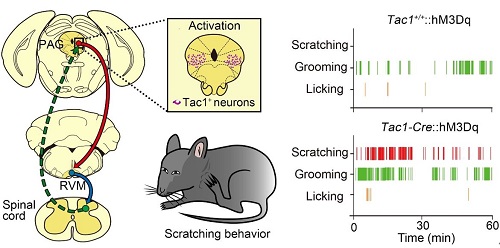Time:2018-12-13
A recent study published in Neuron demonstrated that tachykinin 1 (Tac1)-expressing neurons in the periaqueductal gray (PAG) facilitate the itch-scratching cycle via descending regulation. This work was performed by researchers in Dr. SUN Yan-Gang’s Lab at the Institute of Neuroscience, Chinese Academy of Sciences. By using extracellular recording, fiber photometry, pharmacogenetic, and optogenetic approaches, this work showed that Tac1-expressing neurons in the PAG promote scratching behavior via descending modulation of spinal neurons expressing gastrin-releasing peptide receptor (GRPR), the key relay neurons for itch sensation. This study revealed the cellular and circuit mechanisms underlying descending modulation of itch, which brings new insight to treatment of chronic itch.
Itch is an unpleasant sensation, which leads to scratching behavior. Itch sensation plays an important role in detecting harmful substances, especially those attached to the skin. As itch leads to scratching behavior, this allows the animal to get rid of the harmful substances. Thus, itch sensation is critical for the survival of the animals. However, chronic itch, often seen in patients with skin and liver diseases, remains a challenging clinical problem as uncontrollable scratching causes severe skin and tissue damage. Therapeutic approaches for chronic itch treatment have developed slowly due to the lack of knowledge about the neural mechanism underlying itch processing. Therefore, studying the neural mechanism of itch sensation will help to develop new strategies for treating chronic itch.
In the itch field, lots of efforts have been devoted to understand the mechanism of itch signal transduction and transmission in the peripheral nervous system and at the spinal level. In contrast, little is known about how the itch information is processed in the brain and how the brain can dynamically modulate the processing of itch. Functional imaging studies revealed changes in the activity of the PAG during itch signal processing. In addition, the PAG is well known for its critical role in modulating pain processing at the spinal level via a descending pathway. However, the functional role of the PAG in itch modulation remains unknown.
In this study, SUN’s Lab investigated the cellular and circuit mechanisms underlying the top-down modulation of itch by the PAG through examining the neural dynamics of PAG neurons and the behavioral responses after pharmacogenetic and optogenetic manipulation of different subtypes of PAG neurons. The researchers explored the activity of PAG neurons during the itch-induced scratching behavior, and found that some PAG neurons exhibited scratching behavior-related neural activity. The study further showed that Tac1-expressing glutamatergic neurons in the PAG exhibited itch-selective activity, and that ablating or suppressing the activity of these Tac1-expressing neurons decreased itch-induced scratching behavior. Importantly, activation of Tac1-expressing neurons induced robust spontaneous scratching behavior, which was suppressed by ablation of spinal GRPR neurons, the key relay neurons for itch.
In this project, SUN’s Lab successfully revealed the cellular and circuit mechanisms underlying descending modulation of itch and found a group of Tac1-expressing neurons in the brain that is critical for promoting the itch-scratching cycle. These Tac1-expressing neurons in the brain can be a potential central therapeutic target for breaking the vicious itch-scratching cycle associated with chronic itch. Their findings change the way we could think of to solve the chronic itch problem, and raising the possibility that targeting the brain cells involved in itch processing could be a way in designing new therapeutic methods for treatment of chronic itch.
This work entitled “Tac1-expressing neurons in the periaqueductal gray facilitate the itch-scratching cycle via descending regulation” was published online in Neuron on December 13, 2018. It was carried out mainly by GAO Zheng-Run, CHEN Wen-Zhen, and LIU Ming-Zhe, with help from CHEN Xiao-Jun, WAN Li, ZHANG Xin-Yan, YUAN Lei, LIN Jun-Kai, WANG Meng, ZHOU Li, and XU Xiao-Hong, under the supervision of Dr. SUN Yan-Gang at the Institute of Neuroscience, Chinese Academy of Sciences. This work was supported by the National Natural Science Foundation of China (31771158) and the Strategic Priority Research Program of the Chinese Academy of Sciences (XDBS01000000).

Figure 1. Schematic showing cellular and circuit mechanisms underlying the descending modulation of itch. Tachykinin 1 (Tac1)-expressing neurons in the periaqueductal gray (PAG) promote the scratching behavior by descending modulation the itch processing in spinal cord level. Activation of Tac1-expressing neurons evokes spontaneous scratching behavior.
 附件下载:
附件下载: